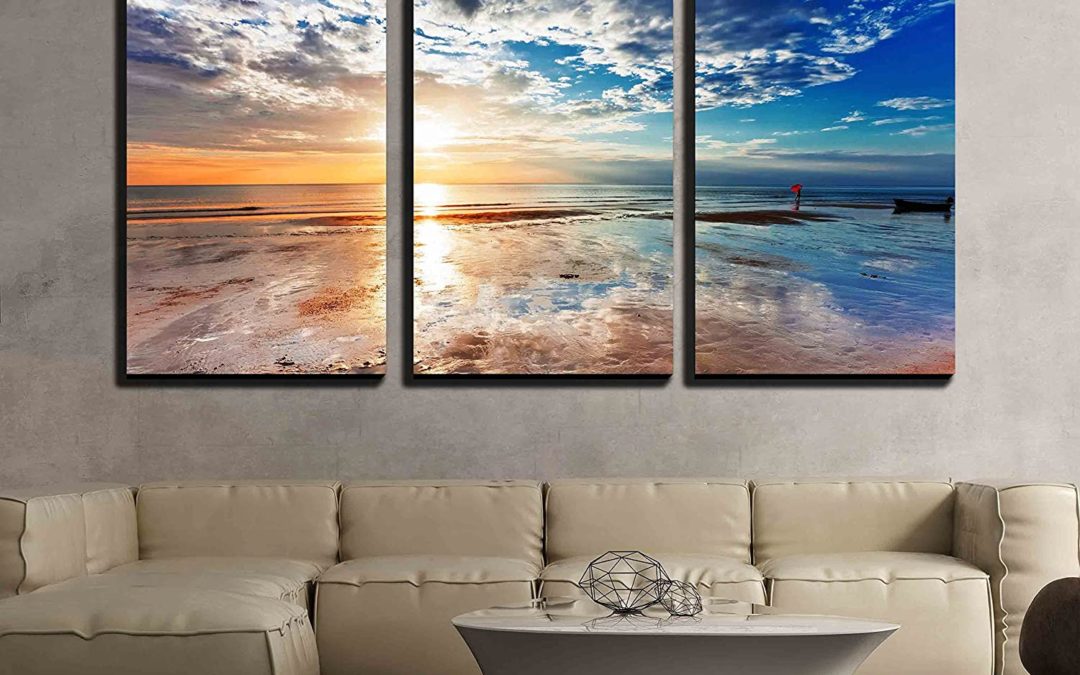You’re at the beach, enjoying your day. As the sun slowly drops, the surrounding environment is colored a deep, atmospheric orange. The sky turns from light blue, to a dark navy. Spots of pink and purple dot the sky, coloring the clouds as well. Sunsets are quite possibly the most gorgeous natural phenomenon, only made better by the fact that they occur every day! While watching the sun disappear into the horizon, have you ever begun to ponder exactly what’s happening in the sky? Is there more to the sunset than meets the eye? Does the sunset hold any interesting secrets? Interested in finding out more? Read below for sunset wall art facts.
Pollution

Did you know that, as unbelievable as it may sound, sunsets are heavily affected by pollution and other negative environmental factors? For instance, smog can greatly influence the color of sunsets. Naturally, you’d assume that pollution dilutes the color of a sunset; in fact, this is flat out wrong! When there is small and large particulate matter in the air, particularly within the lower atmosphere, they absorb more light. This light absorption mutes the color of a sunset, but also scatters different wavelengths of light along the sunset’s horizon. In other words, when the sun is low in the sky during the evening, the sunlight it emits passes through a greater amount of air. This means light in the sky will be scattered all over the place, and leaving a wider ranger of warmly colored light in the sky. Read below for more sunset wall art facts.
Seasons

Have you ever noticed that sunsets tend to be more vibrant and colorful during the fall and winter than in spring and summer? No, you’re eyes haven’t been playing tricks on you; it’s all true! Wondering why? well, there are two main reasons. The first reason is that the sun sets earlier in the winter, which allows for a wider range of colors as it sets. The second reason is that dry, continental air tends to be more prevalent during the winter. This air results in less color “bleed” from beyond the visible spectrum. In other words, this continental air manages to keep the color of a sunset contained and visible to the naked eye for a longer amount of time. Read below for more sunset wall art facts.
Clouds

Just like pollution and seasons, clouds also play a significant role in the way that sunsets look. Most meteorologists believe that clouds that rest higher in the atmosphere tend to produce more colorful sunset than clouds that are only present within the lower layers. Wondering what the science behind this is? Higher clouds have the ability to catch the sunlight rays of the setting sun and reflect it across the ground below. They’re able to do this easily because these clouds are high enough in the atmosphere to catch sunlight that hasn’t lost its color from passing through the several layers of the atmosphere. This is also why you’ll notice the most vibrant colors in a sunset tend to be at the very top of the sky, instead of being low on the horizon. Read below for more sunset wall art facts.
Proverbs

Sunsets, like most things in nature, have been important symbolically for humans across millennia. Over time, they’ve come to symbolize many things. There is a popular adage that says “A red sky at night is a shepherd’s delight! A red sky in the morning is a shepherd’s warning!” Have you ever heard of it? It’s essentially referencing the colors displayed during a sunrise and a sunset. This adage, of proverb, has been around for a long time and is still commonly used today; it’s been used since it was created to predict the next day’s weather conditions. For instance, according the proverb, if the sunset on a particular day leaves behind a colorful red sky, it may be an indication that a storm might be headed your way! Read below for more sunset wall art facts.
Loss

Here’s a question: have you ever noticed that the sun and sky begin losing brightness and layers of color when they begins to drop toward the horizon? This is due to the way that wavelengths work; only certain colors in the spectrum are strong enough to last throughout an entire sunset, which makes some colors more prevalent during one. First, blue color wavelengths disappear. The blues are followed by greens. Those greens are followed by yellow and orange shades. In the end, the only color that remains in the sky is red! That’s why, towards the end of a sunset, you’ll tend to notice that the sky is usually a deep purple-red. Did you enjoy reading these sunset wall art facts?
Conclusion
Now that you know so much about sunsets, what do you think about them? Their secrets have been laid bare, and now you know the reasons for their colors, lengths and hues. Do you find sunsets more interesting? Less interesting? Or, are you as captivated by them now as you were before. We’re sure you’ll never look at a sunset the same way! We hope you enjoyed these sunset wall art facts.

